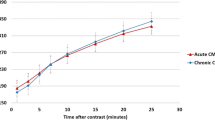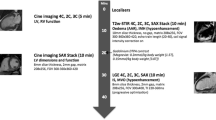Abstract
Purpose
Increased T2 signal intensity (SI) can be regularly observed in myocardial infarction. However, there are controversial reports about the relationship of elevated T2 SI to myocardial viability and some authors propose that high T2 SI serves as a sign of irreversible myocardial injury. This study investigates increased T2 SI compared to myocardial function in patients with reperfused subacute myocardial infarction. Preserved function was used as criterion for viability.
Methods
Ten healthy volunteers and 17 patients with myocardial infarction and patent inlarct related coronary artery were examined on a 1.5 T Magnetom Vision system (Siemens). For T2-weighted MR imaging a breath-hold STIR sequence with dark-blood preparation was used. Cine FLASH 2D imaging was applied to assess myocardial function. Signal-to-noise (S/N) in STIR T2 images was measured in normal and infarcted regions and subsequently identified by two independent observers. Based on a 20 segment model of the left ventricle findings were compared to regional myocardial function.
Results
Elevated STIR T2 SI was found in all 17 patients and observed in 27% (204/754) of segments. S/N of normal myocardium was 5.1 ±0.7 in volunteers and 4.9 ± 0.8 in patients(P=NS). Infarcted myocardium presented with significantly-increased S/N 12.8 ± 1.9 (P < 0.0001). Significant transmural elevation of T2 SI was noted in 32% of segments with preserved systolic function.
Conclusion
Increased STIR T2 SI can be observed transmurally in post-ischemic myocardial regions with preserved function. It therefore cannot be used as an exclusive marker for the non-viable region.
Similar content being viewed by others
References
Kivelitz DE. Taupitz M. Hamm B. Diagnostic assessment after myocardial infarction: What is the role of magnetic resonance imaging. Fortschr Röntgenstr 1999:171:349–58.
Schiefer S. Mallory CR, Katz J, Parkey RW. Buja LM, Wilierson JT. et al. Gadolinium-DTPA-enhanced nuclear magnetic resonance imagingof reperfused myocardium: Identificationof the myocardial bed at risk. J Am Coll Cardiol 1988:12:1064–72.
Lawson MA, Johnson LL. Coghlan L. Alami M. Tauxe EL. Reinert SE, et al. Correlationof thallium uptake with left ventricular wall thickness by cine magnetic resonance imaging in patients with acute and healed myocardial infarcts. Am J Cardiol 1997:80:434–41.
de Roos A, van Rossum AC, van der Wall EE, Postema S, Doornbos J, Matheijsscn NA, et al. Reperfused and nonreperfused myocardial infarction: Diagnostic potentialof Gd-DTPA-enhanced MR imaging. Radiology 1989:172:717–20.
Manning WJ. Atkinson DJ, Grossmann SP, Edelmann RR. First-pass nuclear magnetic resonance imaging studies using gadolinium-DTPA in patients with coronary artery disease. J Am Coll Cardiol 1991:18:959–65.
van Rugge FP, van der Wall EE, Spanjersberg SJ. de Roos A, Matheijssen NA, Zwinderman AH, et al. Magnetic resonance imaging during dobutamine stress for detection and localization of coronary artery disease. Quantitative wall motion analysis using a modification of the centerline method. Circulation 1994:90:127–38.
Ramani K, Judd RM, Holly TA, Parrish TB, Rigolin VH. Parker MA, et al. Contrast magnetic resonance imaging in the assessment of myocardial viability in patients with stable coronary artery disease and left ventricular dysfunction. Circulation 1998:98:2687–94.
Saeed M, Bremerich J, Wendland MF. Wyttenbach R. Weinmann HJ, Higgins CB. Reperfused myocardial infarction as seen with use of necrosis-specific versus standard extracellular MR contrast media in rat. Radiology 1999:213:247–57.
Fullerton GD. Potter JL, Dornbluth NC. NMR relaxationof protons in tissues and other macromolecular water solutions. Magn Reson Imaging 1982; 1:20–1.
Bouchard A, Reeves RC.Cranney G, Bishop SP, Pohost GM. Assessment of myocardial infarct size by means of T2-weighted 1H nuclear magnetic resonance Imaging. Am Heart J 1989:117:281–9.
Lotan CS, Miller SK, Cranney GB, Pohost GM, Elgavish GA. The effect of postinfarction intramyocardial hemorrhage on transverse relaxation time. Magn Reson Med 1992;23:346–55.
Wiscnberg G, Prato FS, Caroll SE, Turner KL, Marshall T. Serial nuclear magnetic resonance imaging of acute myocardial infarction with and without reperfusion. Am Heart J 1988;115:510–8.
Scholz TD, Martins JB, Skorton DJ. NMR relaxation times in acute myocardial infarction: relative influence of changes in tissue water and fat content. Magn Reson Med 1992:23:89–95.
Katz J, Boxt LM, Sciacca RR, Cannon PJ. Motion dependence of myocardial transverse relaxation time in magnetic resonance imaging. Magn Reson Imaging 1990:8:449–58.
Simonetti OP, Finn JP, White RD, Laub G, Henry DA. ‘Black Blood’ T2-wsighted Inversion-recovery MR imaging of the heart. Radiology 1996; 199:49–57.
Winterer JT, Lehnhardt S, Schneider B, Neumann K, Allmann K-H, Laubenberger J, et al. M RI of heart morphology: Comparison of nongradie’nt echo sequences with single- and multi-slice acquisition. Invest Radiol 1999:34:516–22.
Bluemke DA, Boxermann JL, Atalar E, McVeigh ER. Segmented k-space cine breath-hold cardiovascular MR imaging: Part 1. principles and technique. Am J Radiol 1997; 169:395–400.
Kim RJ, Fieno DS, Parrish TB, Harris K, Chen E-L, Simonetti O. et al. Relationship of MRI delayed contrast enhancement to irreversible injury, infarct age, and contractile function. Circulation 1999:100:1992–2002.
Yuasa K. Kazuro S, Kawamitsu H, Tetsuya I, Toshio S, Yutaka I. Quantificationof occlusive and reperfused myocardial infarct size with Gd-DTPA-enhanced MR imaging. Eur J Radiol 1993:17:150–4.
Miller S, Huppert PE. Nagele T, Helbcr U, Brechtel K, Hoffmeister HM, et al. MR-imaging in subacute myocardial infarction: analysisof regional systolic function, perfusion and morphology. Fortschr Röntgenstr 1997:167:399–405.
Krauss H, van der Wall EE, van der Laarse A, Doornbos J, de Roos A, Matheijssen NAA, et al. Follow-up of regional myocardial T2 relaxation times in patients with myocardial infarction evaluated with magnetic resonance imagina. Eur J Radiol 1990;ll:110–9.
Lim TH, Hong M-K, Lee JS, Mun CW, Park S-J, Park SW, et al. Novel application of breath-hold turbo spin-echo T2 MRI for detection of acute myocardial infarction. J Magn Reson Imaging 1997:7:996–1001.
Wu KC, Zerhouni EA, Judd RM, Lugo-Olivieri CH, Barouch LA, Schulman SP, et al. Prognostic significance of microvascular obstruction by magnetic resonance imaging in patients with acute myocardial infarction. Circulation 1998:97:765–72.
Lima JAC, Judd RM, Bazille A, Schulman SP, Atalar E, Zerhouni EA. Regional heterogenity of human myocardial infarcts demonstrated by contrast-enhanced MRI — potential mechanisms. Circulation 1995:92:1117–25.
Saeed M, Wendland MF, Masui T, Higgins CB. Reperfused myocardial infarctions on TI- and susceptibility-enhanced MRI: evidence for loss of compartimentalization of contrast media. Magn Reson Med 1994;31:31–9.
Yu KK, Saeed M, Wendland MF, Dae MW, Velasquez-Rocha S, Derugin N, et al. Comparison of Tl-enhancing and magnetic susceptibility magnetic resonance contrast agents for demarcationof the jeopardy area in experimental myocardial infarction. Invest Radiol 1993:28:1015–23.
Askenasy N, Tassini M. Vivi A, Navon G. Intracellular volume measurement and detection of edema: multinuclear NMR studiesof intact rat hearts during normothermic ischemia. Magn Reson Med 1995:33:515–20.
Garcia-Dorado D, Oliveras J, Gili J, Sanz E, Pérez-Villa F.. Barrabés J, et al. Analysisof myocardial oedema by magnetic resonance imaging early after coronary artery occlusion with or without reperfusion. Cardiovascular Research 1993:27:1462–9.
Miller S, Eckstein FS, Vogel U, Hahn U, Scheule AM, Nägele T. et al. MR signal behaviour of four-week-old occlusive myocardial infarctions in sheep. Fortschr Röntgenstr 2000:172:527–33.
Karolle BL, Carlson RE, Aisen AM. Buda AJ. Transmural distribution of myocardial edema by NMR relaxometry following myocardial ischemia and reperfusion. Am Heart J 1991; 122:655–64.
Author information
Authors and Affiliations
Corresponding author
Rights and permissions
About this article
Cite this article
Miller, S., Helber, U., Kramer, U. et al. Subacute myocardial infarction: assessment by STIR T2-weighted MR imaging in comparison to regional function. MAGMA 13, 8–14 (2001). https://doi.org/10.1007/BF02668645
Received:
Revised:
Accepted:
Issue Date:
DOI: https://doi.org/10.1007/BF02668645




